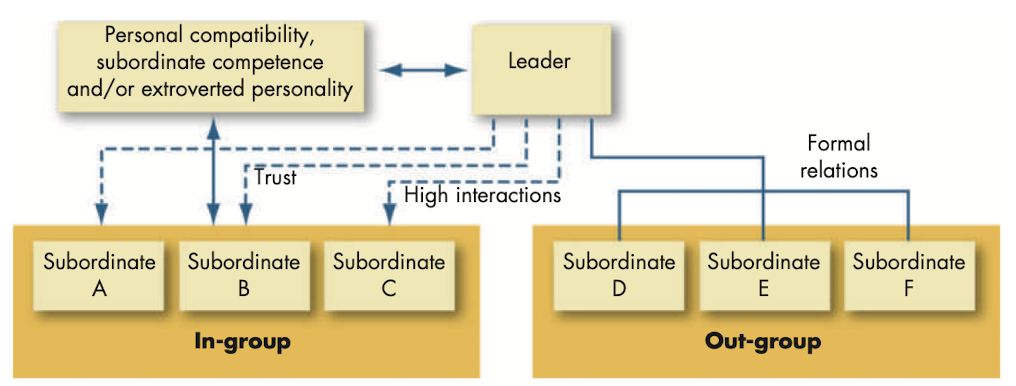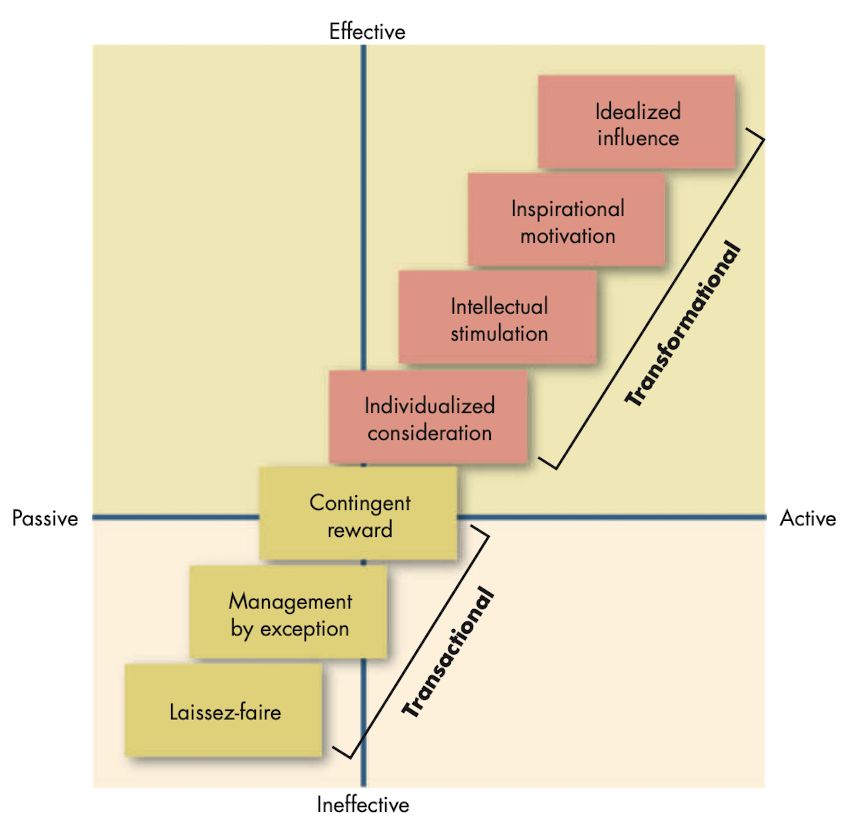
Chapter 12 - Leadership
What is leadership?
Leadership: ability to influence a group toward achieving a set of goals or a vision.
Trait theories
Trait theories of leadership: theories that consider personal qualities and characteristics that differentiate leaders from non-leaders.
Behavioral theories
Behavioral theories of leadership: theories proposing that specific behaviors differentiate leaders from non-leaders.
Ohio State Studies defined two categories of dimensions that substantially affect leadership behavior
Initiating structure: extent to which a leader is likely to define and structure his/her role and those of subordinates in the search for goal attainment.
Consideration: extent to which a leader is likely to have job relationships characterized by mutual trust, respect for subordinates’ ideas and regard for their feelings.
University of Michigan Studies → two dimensions that affect leadership behavior
Employee-oriented leader: leader who emphasizes interpersonal relations, takes a personal interest in the needs of employees and accepts individual differences among members.
Production-oriented leader: leader who emphasizes technical or task aspects of the job.
Contingency theories
Fiedler contingency model: theory that effective groups depend on a proper match between a leader’s style of interacting with subordinates and the degree to which the situation gives control and influence to the leader.
Identifying leadership style
Least preferred co-worker (LPC) questionnaire: instrument that purports to measure whether a person is task-oriented or relationship-oriented.
Defining the situation
Leader-member relations: degree of confidence, trust and respect subordinates have in their leader.
Task structure: degree to which job assignments are procedurized.
Position power: influence derived from one’s formal structural position in the organization; includes power to hire, fire, discipline, promote and give salary increases.
Matching leaders and situations
Evaluation
Situational leadership theory (SLT): contingency theory that focuses on followers’ readiness.
Path-goal theory: theory which states that it is the leader’s job to assist followers in attaining their goals and to provide the necessary direction and/or support to ensure that their goals are compatible with the overall objectives of the group/organization.
Leader-participation model: leadership theory that provides a set of rules to determine the form and amount of participative decision-making in different situations.
Leader-member exchange theory (LMX)
Leader-member exchange (LMX) theory: theory that supports leaders’ creation of in groups and out-groups; subordinates with in group status will have higher performance ratings, less turnover and greater job satisfaction.

Charismatic leadership and transformational leadership
Charismatic leadership theory: leadership theory that states that followers make attributions of heroic/extraordinary leadership abilities when they observe certain behaviors.
Main personal characteristics of followers
Vision and articulation
Personal risk
Sensitivity to follower needs
Unconventional behavior
Transactional leaders: leaders who guide/motivate their followers in the direction of established goals by clarifying role and task requirements.
Transformational leaders: leaders who inspire followers to transcend their own self-interests and who are capable of having a profound and extraordinary effect on followers.

Authentic leadership: ethics and trust
Authentic leaders: leaders who know who they are, know what they believe in and value and act on those values and beliefs openly and candidly. Their followers would consider them to be ethical people.
Socialized charismatic leadership: leadership concept that states that leaders convey values that are other-centred VS self-centred and who role-model ethical conduct.
Servant leadership: leadership style marked by going beyond the leader’s own self-interest and instead focusing on opportunities to help followers grow and develop.
Leading for the future: mentoring
Mentor: senior employee who sponsors and supports a less-experienced employee.
Challenges to the leadership construct
Attribution theory of leadership: leadership theory that says that leadership is merely an attribution that people make about other individuals.
Substitutes: attributes, such as experience and training, that can replace the need for a leader’s support or ability to create structure.
Neutralizers: attributes that make it impossible for leader behavior to make any difference to follower outcomes.
Identification-based trust: trust based on a mutual understanding of each other’s intentions and appreciation of each other’s wants and desires.
Chapter 12 - Leadership
What is leadership?
Leadership: ability to influence a group toward achieving a set of goals or a vision.
Trait theories
Trait theories of leadership: theories that consider personal qualities and characteristics that differentiate leaders from non-leaders.
Behavioral theories
Behavioral theories of leadership: theories proposing that specific behaviors differentiate leaders from non-leaders.
Ohio State Studies defined two categories of dimensions that substantially affect leadership behavior
Initiating structure: extent to which a leader is likely to define and structure his/her role and those of subordinates in the search for goal attainment.
Consideration: extent to which a leader is likely to have job relationships characterized by mutual trust, respect for subordinates’ ideas and regard for their feelings.
University of Michigan Studies → two dimensions that affect leadership behavior
Employee-oriented leader: leader who emphasizes interpersonal relations, takes a personal interest in the needs of employees and accepts individual differences among members.
Production-oriented leader: leader who emphasizes technical or task aspects of the job.
Contingency theories
Fiedler contingency model: theory that effective groups depend on a proper match between a leader’s style of interacting with subordinates and the degree to which the situation gives control and influence to the leader.
Identifying leadership style
Least preferred co-worker (LPC) questionnaire: instrument that purports to measure whether a person is task-oriented or relationship-oriented.
Defining the situation
Leader-member relations: degree of confidence, trust and respect subordinates have in their leader.
Task structure: degree to which job assignments are procedurized.
Position power: influence derived from one’s formal structural position in the organization; includes power to hire, fire, discipline, promote and give salary increases.
Matching leaders and situations
Evaluation
Situational leadership theory (SLT): contingency theory that focuses on followers’ readiness.
Path-goal theory: theory which states that it is the leader’s job to assist followers in attaining their goals and to provide the necessary direction and/or support to ensure that their goals are compatible with the overall objectives of the group/organization.
Leader-participation model: leadership theory that provides a set of rules to determine the form and amount of participative decision-making in different situations.
Leader-member exchange theory (LMX)
Leader-member exchange (LMX) theory: theory that supports leaders’ creation of in groups and out-groups; subordinates with in group status will have higher performance ratings, less turnover and greater job satisfaction.

Charismatic leadership and transformational leadership
Charismatic leadership theory: leadership theory that states that followers make attributions of heroic/extraordinary leadership abilities when they observe certain behaviors.
Main personal characteristics of followers
Vision and articulation
Personal risk
Sensitivity to follower needs
Unconventional behavior
Transactional leaders: leaders who guide/motivate their followers in the direction of established goals by clarifying role and task requirements.
Transformational leaders: leaders who inspire followers to transcend their own self-interests and who are capable of having a profound and extraordinary effect on followers.

Authentic leadership: ethics and trust
Authentic leaders: leaders who know who they are, know what they believe in and value and act on those values and beliefs openly and candidly. Their followers would consider them to be ethical people.
Socialized charismatic leadership: leadership concept that states that leaders convey values that are other-centred VS self-centred and who role-model ethical conduct.
Servant leadership: leadership style marked by going beyond the leader’s own self-interest and instead focusing on opportunities to help followers grow and develop.
Leading for the future: mentoring
Mentor: senior employee who sponsors and supports a less-experienced employee.
Challenges to the leadership construct
Attribution theory of leadership: leadership theory that says that leadership is merely an attribution that people make about other individuals.
Substitutes: attributes, such as experience and training, that can replace the need for a leader’s support or ability to create structure.
Neutralizers: attributes that make it impossible for leader behavior to make any difference to follower outcomes.
Identification-based trust: trust based on a mutual understanding of each other’s intentions and appreciation of each other’s wants and desires.
 Knowt
Knowt
